The Hook: Scene Transitions in Classical Cinema
January 2008
How do movies carry us from scene to scene? The question is simple, but not
many people have explored it. I’m especially interested in how transitions
are managed in mainstream, mass-audience movies, but I’ll have some things
to say about other traditions too.
I’ll also be talking a lot about unity, which can make the whole exercise
seem fairly old-fashioned and Aristotelian. Yet examining how films create internal
patterns reminds us that those patterns are almost always aimed at the audience.
We’re supposed to register those patterns, consciously or not, and they
prompt us to react in particular ways. As so often, when we talk about form we’re
actually talking about the psychology of spectators.
A movie’s architecture
If we want to know how mainstream movies take us from scene to scene, I suggest
we start by acknowledging three different levels of architecture.
First, we can consider our film as having large-scale
parts. Call this macrostructure—the
way those biggish parts fit together.
We might treat reel lengths as
the salient parts, as silent filmmakers and Hong Kong filmmakers sometimes did.
More recently, we’re urged to think
of the large-scale parts as acts, either three in the current Hollywood
advice books or four, as Kristin Thompson and I have suggested. But these more
or less material divisions tally up with phases of the story action. So, for
example, the traditional conception of three-act structure depends on the main
characters choosing goals, being blocked in achieving them, and at the climax
decisively achieving them or not.
In National Treasure (2004), Benjamin
Gates is searching for the treasure of the Knights Templar. He’s kept from
achieving this goal by conflicts, obstacles, and delays. In the film’s
first part, he and his assistant Riley learn that directions to the treasure
are inscribed on the back of the US Declaration of Independence. But Ben’s
former backer Ian is also on the trail of the map, so our heroes acquire another
goal: to protect the Declaration. At the turning point of the first part, Ben
decides that the only way to achieve his goals is to steal the Declaration. In
the second part, Ben and Riley make off with the document, picking up archivist
Abigail along the way. The third part consists of following the trail of clues
laid out in the coded message, as our three are pursued by Ian’s gang and
by the FBI. The film’s fourth part constitutes
a climax. The trail leads to Manhattan, where Ian takes our heroes hostage and
they plunge into a lair underneath a church. The treasure is discovered, Ian
is defeated, and in an epilogue the protagonists are rewarded.
For more on macrostructure, see the essay, “Anatomy
of the Action Picture” elsewhere
on this site.
At a lower level, we can think of the film as having midsize
parts, usually called scenes or sequences.
These parts, usually 30 to 50 in a modern feature, are tied together in particular
ways. Typically the scenes develop and connect through short-term chains of cause
and effect. Characters formulate specific plans, react to changing circumstances,
gain or lose allies, make appointments, act under deadlines, and otherwise take
specific steps toward or away from their goals. Part of the screenwriter’s
craft is to find ways to fit the short-term actions into the overarching movement
toward resolution.
In National Treasure, for example, the first large-scale part consists
of concrete actions that flow naturally out of the goals. To find the treasure,
Ben and Riley and their opponents need the map. The map is on the Declaration
of Independence. Ian will try to steal it, so Ben tries to alert the FBI, but
he’s considered a crank. He tries to get permission to look at the Declaration,
but that effort fails too. So he is obliged to protect it from Ian by stealing
it himself. This cascade of choices, actions, and reactions flows logically out
of his double goals: to find the treasure and to protect the Declaration.
This second level of structure isn’t quite as linear
as I’ve made
it out, since well-constructed plots interweave various elements from earlier
scenes into the development of later scenes. Appointments and deadlines illustrate
this strategy. So does a causal chain that’s left unresolved in one scene.
Kristin and I have called this device the dangling cause, and it is
very common in Hollywood dramaturgy. For example, in National Treasure,
when calling on Abigail to seek permission to examine the Declaration, Ben notices
a folder advertising an archive reception. Several scenes later we learn that
that reception will be the occasion on which Ben and Riley pull off their heist.
Because of this weaving of causes and effects, we might best call this midlevel
architecture the level of plot coherence: each scene is designed
to advance the action but also to develop or tie off lines of activity set off
earlier.
A third, still finer-grained level of organization is what
I’ll
call microstructure.
This is the tangible, moment-by-moment texture, conceived as a pattern of images
and sounds. For example, within a scene, we often find patterns of cutting—an
establishing shot, reverse angles, close-ups, and so on—meshed with the developing
dialogue. The audiovisual patterning carries the story along bit by bit, and
these bits we take in and assemble into larger patterns of intelligibility, such
as Ben and Riley fail to persuade Abigail to let them study the Declaration.
Likewise, in action sequences, cutting, composition, point of view, sound-image
interaction, and the like carry the discrete developments of the action, which
we intuitively pull into a larger unit, such as Ben, Riley, and Abigail escape
Ian and keep custody of the Declaration.
Global macrostructure, midlevel
plot coherence, and audiovisual texture or microstructure: we can study a film’s
narrative at any of these levels. Usually we hop back and forth among them, searching
for patterns that yield significant effects on the viewer’s experience.
I’ll try to convince you that transitions
play an important role in those patterns.
Meet the Hook
Most scene transitions facilitate the first and second
levels of unity. In many films, a fade-out marks the end a discrete “act.” At
the midrange level of coherence, the end of one scene and the beginning of another
will often be marked in a conventional way, by a disjunctive cut or a burst of
music. Usually, however, the immediate blow-by-blow action of scene A and its
audiovisual texture aren’t linked directly to that of Scene B.
Take an example from National Treasure. Kicked out by the FBI, Riley
says that they have no one to turn to, but Ben says that they need someone who’s “passionate.”

Cut to the exterior of the National Archives building, then a close-up of
the flyer for the gala that will be so important in the second part.
 
After several more shots, Ben and Riley are ushered in to meet Abigail.
 
The first part of the scene has left the causal line of the men’s search dangling
in order to wedge in the motif of the reception brochure. Now their hunt for
a helper resumes.
But suppose things were presented differently. Suppose that after Ben says they
need someone passionate, we cut directly to the close-up of Abigail on the phone.
That would be an example of the sort of transition that most interests me in
this essay: The hook.
In our book The Classical Hollywood Cinema, we
called it that, and nowadays some screenwriters use the term too. 1 Here
the audiovisual texture links a specific causal element the end of one scene
to that at the very start of the next. The second, in a concrete way, completes
the element we see or hear at the end of the first scene. 1 Here
the audiovisual texture links a specific causal element the end of one scene
to that at the very start of the next. The second, in a concrete way, completes
the element we see or hear at the end of the first scene.
At a later point in National Treasure, driving away from the scene of
their robbery, Ben mentions the clues in “those letters.” “What
letters?” asks Abigail, over a shot of the van. Cut to an extreme long
shot of the van parked, Ben pacing outside it. Abigail is saying, “You
have the original Constance Dogood letters.”
 
Scene A ends with a question; scene B opens with the answer.
This is a common way a hook is used, though we’ll see that principles of
continuity or contrast can work as well.
But first, let’s map the possibilities. Confining ourselves for the moment
to sound cinema, we can ask: What can hook to what? There are four simple possibilities.
1.) A sound can hook to another sound. Typically,
a line of dialogue at the end of scene A links directly to a line at the start
of scene B. That’s what happens in the Constance Dogood instance. Here’s
another example from National Treasure. Riley is insisting that the
Declaration is impossible to steal. On the steps of the Lincoln Memorial, he
says, “Let me prove it to you.” Cut to the dome of the Library of
Congress.
 
At the visual level, this might seem not to be a tight
link; isn’t it
like the exterior shot of the National Archives in the default example? What
creates the hook is the second shot’s use of Riley’s voice, which
says that he has brought Ben to the Library of Congress to convince him to “listen
to Riley.” This is the proof he proffered in his final line of the previous
scene.
So this first type of hook is easy to test for. Just ask: Would it work on radio?
2.) A sound can hook to an image. Usually
the sound is a line of dialogue. In CHC, we called this a “dialogue
hook.” Lewis
Herman, in his indispensable book on screenwriting, calls it a “dialogue
transition.” 2 2
This is the most common sort of hook in National Treasure, and it provides
some clever transitions. When Ben and Abigail are trying to bring out the cipher
on the back of the Declaration, they squeeze on lemon juice and blow fervently
on the paper. The image clarifies.
 
Ben: “We need more juice.” Abigail: “We
need more heat.”
 
Cut to a bowl of lemons, then to a drawer opening to reveal a hair dryer.
 
Ben and Abigail proceed to coax the code out of the paper.
This is a double dialogue hook, “juice” answered by the lemons
and “heat” answered by the dryer. The double entendre adds a nice
twist, for the scene captures the erotic energy—juice and heat—Ben
and Abigail share in making a historical discovery.
3.) An image can hook to an image. This
is rarer than the first two types, but the first hook in National Treasure illustrates
the possibility. In the prologue, as a boy Ben learns of the Templars’ treasure
from his grandfather. Grandpa Gates asks him to take on the duty of protecting
the treasure and the family name. “I so swear.” The young Ben raises
his head as the music starts to rise as well.

Cut to Ben, now a man, raising his head as he and Ian drive across the arctic
wastes to find the buried ship, the Charlotte.

The match-on-action across years is driven home by a rhythmic shift in the
score and a new, urgent brass theme.
The image-based hook is somewhat more common in the 1920s and 1930s, I think.
Ozu uses it a lot, and here is an example from Fritz Lang’s You Only
Live Once (1937). We dissolve from a cluster of parcels in an office to
the same parcels, now opened at home.
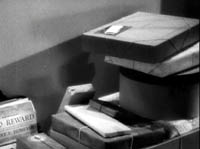 
Lang, as we’ll see below, is one of the early masters
of the hook.
4.) An image can hook to a sound. This seems to be the rarest
sort of audiovisual transition, and pure examples are hard to find. Imagine a
shot of a commander signing an order for a prisoner to be shot by a firing squad.
Cut to darkness and the sound of a fusillade; fade up to show the prisoner lying
dead against the wall.
I don’t find an instance in National Treasure, but Kristin suggests
one example from Groundhog Day. Phil the weatherman has already been
through one day’s repetition of events. He tests whether tomorrow will
be the same by breaking a pencil and putting the pieces on his bedside table.
He lies there propped up and watching the digital clock face. He evidently intends
to stay up all night to see what happens around six o’clock.
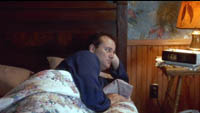
Cut to an extreme close-up of the clock face changing to
6:00 and the tune, “I’ve
Got You Babe.” Cut to Phil, who has fallen asleep, snapping bolt upright.
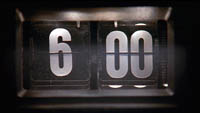 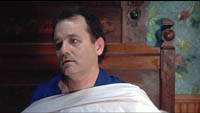
Although the shot of the clock indicates a new scene, the
basic logic of the transition moves us from an image posing a question to a crucial
sound that answers the question. After all, 6:00 AM comes every day, but “I’ve Got You
Babe” doesn’t, thankfully. Director Harold Ramis could just as easily
have cut to a black frame and simply let us hear the tune, and we’d know
that Phil’s fears are now confirmed. Interestingly, we don’t see
the pencil at first; it’s the sound that tells us that the day is repeated,
and the restored pencil confirms it.
Playing games and finding functions
This catalogue is merely a first effort to pick out the possibilities. But we
need to recognize that the hook need not be literal or on the nose. It can be
ironic or nugatory, metaphorical or misleading. We find a deflationary negative
hook in one episode of The Simpsons. Homer: “I predict that this
is the last we’ll be hearing about prohibition.” Cut to enraged women
chanting: “We want prohibition!”
 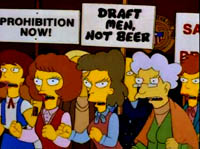
National Treasure creates a playful narration
by means of some misleading hooks. Riley is parked outside the National Archives,
checking on some video installations he’s made that will monitor Ben’s theft. When he finds
they work, he says, “Game on.”

Cut to a digital readout counting down from 3 to End.

A timer in his equipment? Nope; a microwave oven in which Ben is preparing
lasagna before he settles down to studying plans.
 
What we took as a continuity cut within a scene was a hook
between scenes. A similar effect arises in a transition from Donnie Brasco,
pointed out by Jeff Smith. Lefty is headed out of his apartment, knowing he’ll
be killed. Cut to a black frame.
 
Over the black frame we hear a gunshot. Cut to a target
on a shooting range, then to Donnie firing.
 
It’s a rare case of an image/sound hook, but it’s
made ambiguous by the two ways we can take the pistol shot. The sound of the
shot indicates Lefty’s death, although it is retrospectively linked to
the firing range (it sounds the same as the other rounds Donnie fires). Metaphorically,
of course, it underscores the fact that Donnie is responsible for Lefty’s
death.
And hooks can be combined and embedded. We’ve already seen one instance
in National Treasure, the double hook on juice and heat. Here’s
another from the same movie. Sadusky, the FBI officer, is questioning Ben’s
father and assures him, “Don’t worry, Mr. Gates. We’ll find
your car—and your son.”

Cut to the Cadillac hood ornament, and tilt up to show Ben driving.
 
The two dialogue elements, car and son, have been linked
to the visual ones, and in that order. With the redundancy characteristic of
Hollywood, Riley, dozing in the back seat, murmurs, “Your dad’s got
a sweet ride.”
We’ll consider some other complicated cases later, but we should have enough
examples to begin to ask about functions. What purposes are fulfilled by the
hook? Why should we have the hook at all?
Lang, who used sound/sound hooks extensively in M (1931),
explained two reasons behind his choice. First, breaking off a line and completing
it with another in the next scene “not only accelerates the tempo of the
film but also strengthens the dramaturgically necessary association of thoughts
between two successive scenes.” 3
So we gain pacing, an impression of rapid narration, as if there were no time
wasted on establishing shots and other padding. We also gain emphasis: the core
motifs of a scene can be brought directly to the viewer’s
attention. In many cases, however, this second condition isn’t met; in
many of the National Treasure examples, the hooking elements are peripheral
to the scene (the lasagna, the Cadillac). 3
So we gain pacing, an impression of rapid narration, as if there were no time
wasted on establishing shots and other padding. We also gain emphasis: the core
motifs of a scene can be brought directly to the viewer’s
attention. In many cases, however, this second condition isn’t met; in
many of the National Treasure examples, the hooking elements are peripheral
to the scene (the lasagna, the Cadillac).
An implication of Lang’s point
is that hooks create a more overt narration. They address the audience more or
less directly, letting us put the scenes together without benefit of character
exposition. This sort of direct address can work in classical films because the
beginnings and endings of scenes are typically the most overt portions. (Some
theorists have claimed that Hollywood storytelling is “transparent,” but
this quality actually fluctuates across the film and across individual scenes.)
This overt narration can build up a sense of cleverness or resourcefulness or
sophistication.
In some of the more complex cases, the hook also functions
as useful disorientation. It provides a bump, asking us to be alert and find
a fresh way to fit together what was just said or shown.
One of the most interesting
functions of the hook is that the strong audiovisual cohesion it yields can give
the impression of a tightly unified film. This could be valuable in the case
of a movie that lacked plot coherence or a balanced macrostructure. That is,
clever hooks can mask a weakly plotted movie. You might argue that the strong
local connections among scenes in National Treasure distract
us from the massive improbabilities of the action.
Most rarely, I think, reliance
on hook-transitions can feed into a larger strategy of narrational manipulation.
The key example would be, again, You Only Live
Once. I must speak generally so as not to spoil the film if you haven’t
seen it. Here the hooks are part of a larger system of ellipses between scenes.
At first those ellipses don’t conceal important story information, but
at a crucial point they do. Lang trains us to see the hooks as innocent, if flamboyant,
gestures, but in fact they lull us into trusting this narration, which brutally
betrays us.
The hook in history
Where, finally, did
the hook come from?
We can find it in literature, although exact analogies
are complicated. Certainly hooks are common in today’s popular fiction; I append
some examples at the end of this essay. But did the device originate in the nineteenth-century
novel? I leave that for literary researchers to determine.
In cinema, it’s clearly a device of classical filmmaking. It flourished
in the 1930s, not only in You Only Live Once but in Penthouse (1933)
and The Case of the Lucky Legs (1935; discussed in The Classical
Hollywood Cinema). It can be seen in Hitchcock’s The Man Who Knew
Too Much (1934) as well, and of course Welles makes much of hook tactics
in what he called the “lightning mixes” of Citizen Kane (1941).
How far back can we trace it? Noël Burch argues that
Lang in effect invents the hook in Dr. Mabuse der Spieler (1922), especially
in the way that intertitles work with the images that precede and follow them. 4 When
the police inspector von Wenk speculates that all the mysterious men might be
the same person, we cut to Mabuse in his laboratory; the shot confirms von Wenk’s
hypothesis. 4 When
the police inspector von Wenk speculates that all the mysterious men might be
the same person, we cut to Mabuse in his laboratory; the shot confirms von Wenk’s
hypothesis.
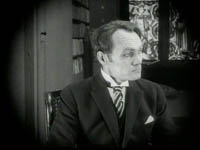 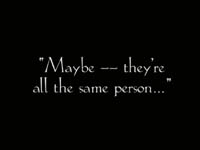 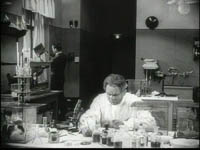
But we ought to note that the “hooking” transitions
in Mabuse tend
to occur not between scenes but between two crosscut threads of a single long
sequence. Silent films were typically built out of long sequences, often crosscut
ones that trace parallel lines of action. When talkies came in, sequences grew
shorter and more numerous, and crosscutting was chiefly assigned to situations
of suspense.
In any case, before Mabuse, other films were using
the sort of hooks that Lang did. For instance, in The Penalty (1920),
the cops discuss Blizzard, the gangster played by Lon Chaney, and the dialogue
hooks are aligned with shots identifying him.
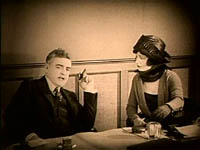 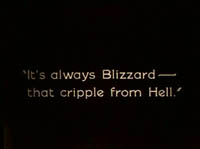 
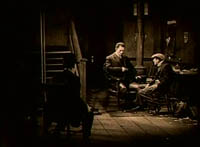 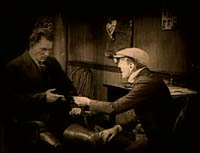
Other examples can be found in The Whispering Chorus (1919)
and A
Delicious Little Devil (1919). Granted, these passages are not quite as
crisp and curt as Lang’s juxtapositions, but they might be considered intermediate
steps toward what Lang would do. In the Penalty passage, it isn’t
difficult to see that you could cut straight from the dialogue title to a close
shot of Blizzard interrogating his minion. Changes in stylistic history can arise
from tightening up a schema, making it less redundant.
Lang applied the tighter
version to M, and it’s likely that that
film was influential in popularizing these practices for Hollywood in the 1930s.
Filmmakers of the sound era started to take audiovisual texture very seriously,
and as scenes became shorter, cohesion tactics became more valuable. Hooks are
today written into the script, even if they aren’t used or are replaced
by different ones. 5 A
remark of Elmore Leonard’s about writing screenplays confirms the importance
of transitions in modern cinema. “I like to add scenes, but then when it
comes to the transitions you’re in big trouble. You can’t just stick
a scene in because you feel like it.” 5 A
remark of Elmore Leonard’s about writing screenplays confirms the importance
of transitions in modern cinema. “I like to add scenes, but then when it
comes to the transitions you’re in big trouble. You can’t just stick
a scene in because you feel like it.” 6 6
Revising the schema
Because the hook is a classical device, we might be inclined to expect that other
traditions don’t make use of it. This belief isn’t wholly wrong.
Maurice Pialat asked a would-be editor: “Do you like films in which the
guy says, ‘Let’s go to the sea,’ and the next scene is on the
seashore?” 7 7
It isn’t hard to find films outside the mainstream
that deny us such hooks. A notable example is Michael Haneke’s 71 Fragments
of a Chronology of Chance (1994), in which each scene is separated off from
the others by black leader and silence, refusing the forward tug of the action.
But more interestingly, we find that “art movies” use hooks too.
Bresson does it in an effort to be laconic. At the beginning of Au hasard
Balthazar (1966), Marie’s
father refuses to buy the donkey, but in the next shot we see him leading it
off. Hooks can also be comic, as in Tsai Ming-liang’s What Time Is
It There? (2001). What we get is a process not of simple refusal but of
borrowing and transformation, schema and revision. A lot of art cinema takes
Hollywood devices and repurposes them.
This isn’t to say that classically constructed films don’t revise
their inherited devices too. This can sometimes occur in those virtuoso moments
so beloved of contemporary Hollywood. One last time, consider National Treasure.
Ben, Riley, and Abigail are in a mall shop when they realize
the import of a clue issuing from the Declaration. It steers them to the clock
tower on Independence Hall, which is represented on the hundred-dollar bill.
Ben realizes that the clock and the time indicated on it point to the next clue
in the hunt. But today, they believe, the appointed hour has passed. But Riley
reminds them that daylight savings time began after the revolutionary period,
so as per the clue’s dictates, they have an extra hour today. The couple rush
off and call out the name of the man who first suggested daylight savings time: “Benjamin
Franklin!” Cut
to Ian, offering a hundred-dollar bill to the little boy who had helped Riley
crack the clue leading to Independence Hall.
In a movie that relies so heavily
on hooks, this transition intertwines them in felicitous ways. The mall scene
ends with Ben and Abigail calling out Franklin’s name. This is an oblique sound/
image hook to the second shot in the following scene, when a reverse angle picks
up the bill and Franklin’s portrait on it.
 
It’s not irrelevant that our hero’s full name is Benjamin
Franklin Gates.
Even more subtly, earlier in the first scene, Ben’s optical
point-of-view shot underscored the clock motif as he began to understand the
clue. (The framing of Ben and the bill will be mirrored by a reverse shot of
Ian, his adversary.)
 
The clock motif is picked up in the initial shot of the
following scene, as the little boy examines the bill.

But Ian is blind to the significance of the
clock that is literally staring him in the face. He will soon have to resort
to the duffer historian’s tool, a Yahoo! search.
As a storytelling device, the
hook affects both narrative design and stylistic patterning. Studying it helps
us grasp some basic mechanics of classical storytelling. Just as important, these
devices display tacit knowledge and decisions on the part of filmmakers, who
adapt traditions to the needs at hand. And filmmakers’ tacit
knowledge corresponds to that of audiences, the skills you and I exercise unawares.
We can follow the corrugations of sound/ image organization because we know about
the world outside cinema, we know how conventions reshape that world, and we’re
alert for narrative and audiovisual organization. Analyzing how movies are put
together helps us understand how we experience them.
Appendix: The hook in literary texts
George Pelecanos, The Night Gardener (New
York: Little, Brown, 2006). Scene change within Chapter
Twenty-Five, p. 231:
“Let’s
get a beer or something,” said Holiday.
“Drop
me at my car,” said Ramone.
“C’mon,
Ramone. How often do we see each other? Right?”
“I’ll
have a beer,” said Cook.
Ramone looked
over the bench at Cook. He seemed small, leaning against the door in the front
seat of the car.
“Okay,” said
Ramone. “One beer.”
Ramone
was finishing his third beer as Holiday returned from the bar with three more
and some shots of something on a tray.
Elmore Leonard, Unknown Man #89 (New
York: Harper, 2002). End of Chapter 12, p. 144:
Ryan saw the
manager. The manager said he had just talked to the police. Who was this girl,
anyway? What’d she do? She certainly hadn’t worked for Uncle Ben.
Maybe
not, but for some reason she had used the address. She was around, somewhere.
That
was on a Monday.
Chapter 13[p. 145]:
Wednesday
afternoon, Ryan was sitting in a bar on Saginaw Street in Pontiac.
Ian Rankin, The Naming of the Dead (New
York: Little, Brown, 2007). Scene change within Chapter 3, p. 62:
Rebus finished the call, decided to check for messages. There was only the one.
Steelforth’s voice had gotten just a dozen words out before Rebus cut it
off. The unfinished threat echoed in his head as he crossed to the stereo and
filled the room with the Groundhogs.
Don’t
ever try to outsmart me, Rebus, or I’ll…
“…break
most of the major bones,” Professor Gates was saying.
He gave a shrug. “Fall like that, what else can you expect?”
1 : Karl
Iglesias, “8 Ways to Hook the Reader,” Creative Screenwriting 13,
4 (2006), 48–49.
2 : Lewis
Herman, A Practical Manual of Screen Playwriting for Theater and
Television Films (New York: New American Library, 1974; orig. 1952), 134–152.
3 : “Fritz
Lang on M: An Interview,” Criterion DVD
booklet for M (1998), trans. from Gero Gandert interview in Fritz
Lang: M-Protokoll (Hamburg: Marion von Schroeder, 1963).
4 : Burch
discusses these matters in several places. See “Fritz
Lang: German Period,” In
and Out of Synch: The awakening of a Ciné-Dreamer (Aldershot,
England: Scolar, 1991), 3–31; “Notes on Fritz Lang’s first Mabuse,” In
and Out of Synch, 205–227; and “De ‘Mabuse’ à ‘M’:
Le travail de Fritz Lang,” in Cinéma: Théories, lectures,
ed. Dominique Noguez (Paris: Klincksieck, 1973), 227–248.
5 : A late
script draft of National
Treasure, dated
9 April 2003 by Cormac and Marianne Wibberley, includes some intriguing hooks
that were not used in the final film.
6 : Quoted in Woody Haut, Heartbreak
and Vine: The Fate of Hardboiled Writers in Hollywood (London:
Serpent’s Tail, 2002), 224.
7 : Yann Dedet, quoted in
Roger Crittenden, Fine
Cuts: The Art of European Film Editing (Boston: Focal Press, 2006), 26. |



